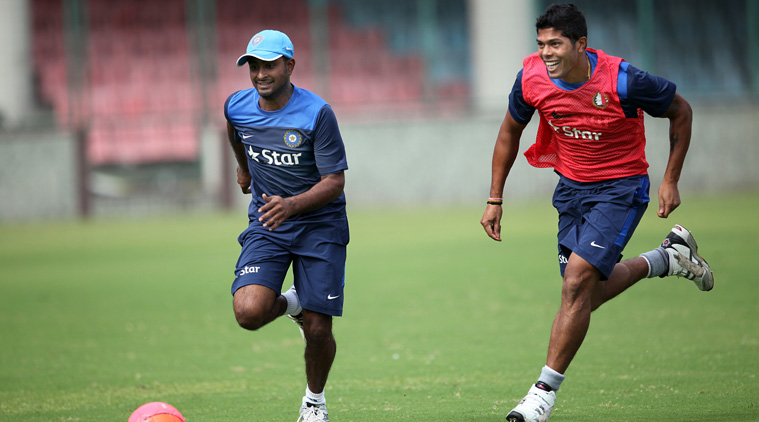2015 World Cup squad: Despite a glaring weakness, best possible India team has been picked
The selectors would have liked a few more fast bowling options but the truth is they don’t exist!.
 2015 World Cup squad: With the reserve batsman needing to be a middle order player, you really couldn’t look beyond Ambati Rayudu.
2015 World Cup squad: With the reserve batsman needing to be a middle order player, you really couldn’t look beyond Ambati Rayudu.
This team is as predictable as mess food and away performances. As predictable as verbal brawls on the news and a large Australian total. It can mean two things. Either that the team is settled, which is a good sign, or that the selectors didn’t have too many options, which isn’t.
I believe a post announcement anti-climax is a good thing. Almost everybody would have got fourteen names right and if you got less than thirteen, you are either out of touch with the game or have a passionate contrarian view. So let us go straight to the fifteenth.
The selectors could have picked an extra seamer in Mohit Sharma or Dhawal Kulkarni on the premise that you would play three everytime and wanted to cover for a couple of niggles. But there are so many days between games that niggles can be sorted and, in any case, a bowler only has to bowl ten overs and field for three and a half hours; and they have fielded for a lot longer in the Test matches!
You could have picked an extra batsman in Murali Vijay or Robin Uthappa. Now, because of the way limited overs cricket is played, and the fact that there are three players who can open the batting with some proficiency, Dhawan, Rohit Sharma and Rahane, the need for a reserve opener wasn’t felt. That came in the way of Murali Vijay being picked who, it hardly needs reminding, has been an outstanding T20 cricketer.
With the reserve batsman needing to be a middle order player, you really couldn’t look beyond Ambati Rayudu. In a career marked by turbulence rather than stability, he has done everything asked of him with runs in England and at home and, most important, in run chases. The fact that he can keep wickets (“can keep” as opposed to “does keep” being a critical difference!) meant that the need to pick a batsman-keeper was no longer paramount. Otherwise, there is little doubt that Robin Uthappa would have been in this team.
With three spinners mandatory, and four unnecessary, it meant that the selectors could look at a floater as the fifteenth player. I believe the selection of Stuart Binny is to give the team an option should a fresh surface suddenly materialise. Or, more important, should a quarter-final in New Zealand become a possibility. You could pop back there, if you topped the group of course, and be faced with a cold, windy day in a knock out game. You could of course play four seamers but that depletes the batting substantially. Binny at 7, even 8, and the provider of 6-7 overs suddenly becomes a good option.
In away conditions, a seam bowling all-rounder, ideally someone who bats in the top six, gives you great balance. India’s all-rounder in the top six is a wicket keeper but the big strength of this side is that each of the three spinners picked is an all-rounder; maybe Jadeja from 7 and Ashwin from 8 but they allow you to play the best three seamers without worrying about their batting too much. In any case, there is always a slogger hiding within a fast bowler!
The biggest strength of this side is the experience it carries and that is something Dhoni had emphasised a couple of years ago. The top six are settled and each of those is, on his day, a match winner.
Rohit and Rahane can easily interchange from No 2 to 4, Kohli is in a class of his own and in Raina and Dhoni there are finishers of the highest calibre. The spinners bat, so can Bhuvaneshwar at 9 and that means most days India will be a top quality batting side.
Good ground fielding side
It is also as good a ground fielding side as any that has played for India. In fact, probably the best with Kohli, Raina, Jadeja, Rahane and Rohit being seriously good. There are decent throwing arms there which becomes a factor in Australia and slip catching, which is the biggest fielding weakness, isn’t as substantial a factor.
The biggest weakness is the inability to take wickets. Teams that play India are now aware that if they don’t lose wickets early, and that is not too difficult to be honest, they can score heavily at the death. In recent times, India’s seamers average 9/over in the last ten overs and often teams have gone past 100 in that phase. Not losing wickets early means the opposition is able to milk the spinners with only four fielders allowed outside the circle. Scoring 300+ against India is no longer an event, more a norm.
The selectors would have liked a few more fast bowling options but the truth is they don’t exist!
If India have to retain the World Cup, the bowlers have either to surprise everyone or the batsman have to score so heavily as to make their job easier. It would help if the wickets are tired because that would bring India’s strength, slow bowling, into the picture. And the long boundaries in Australia (but definitely not in New Zealand!) would help too.
But if India don’t, they can at least say they went with the best team they could have gone with!































